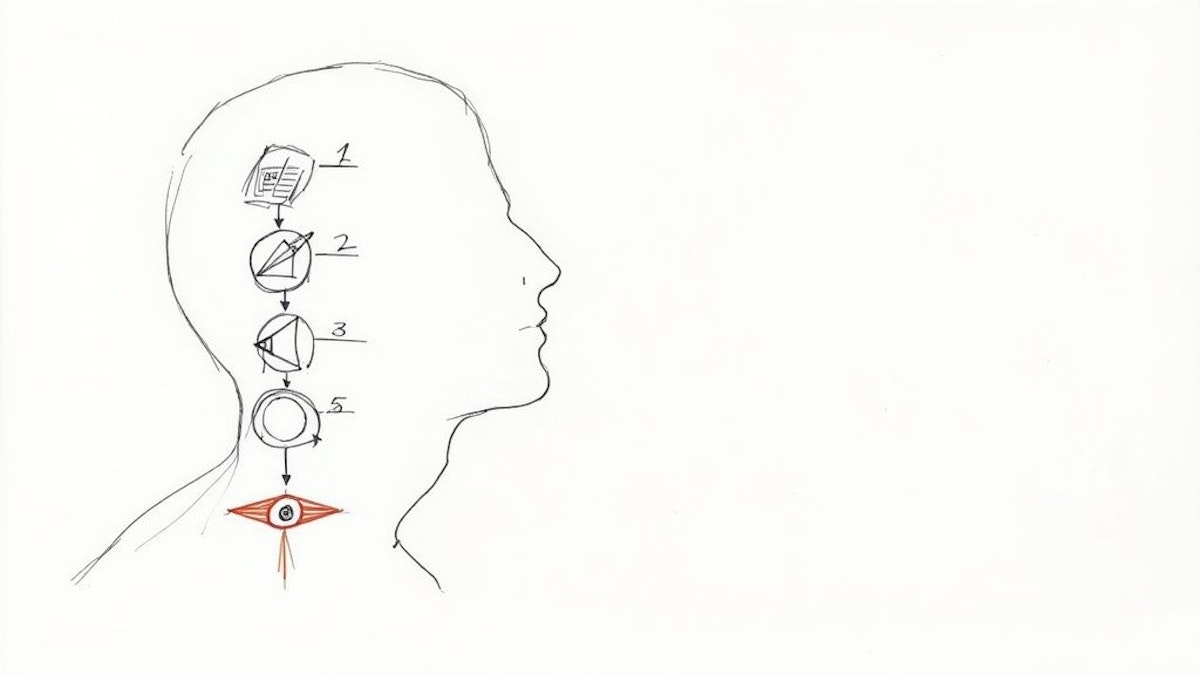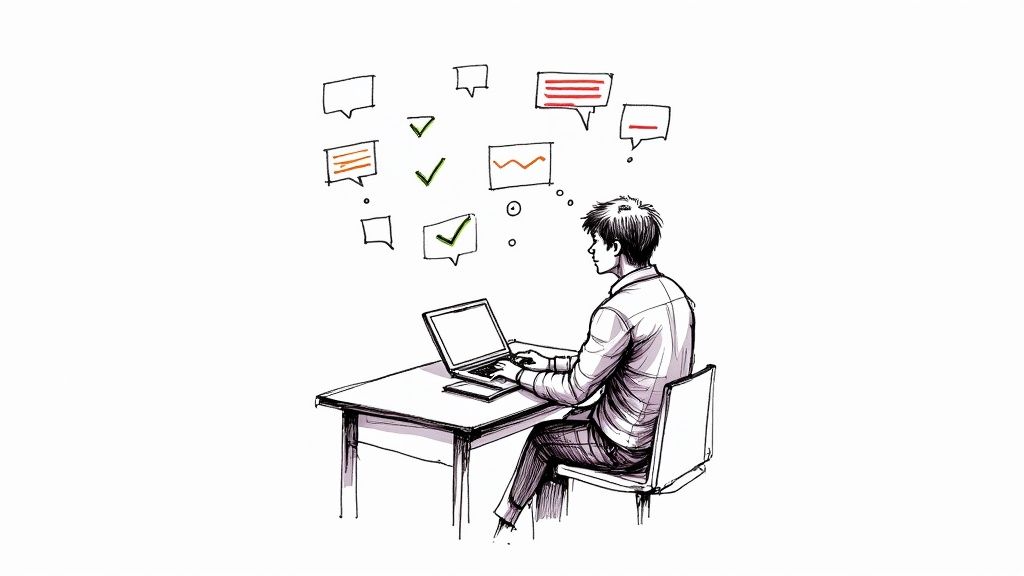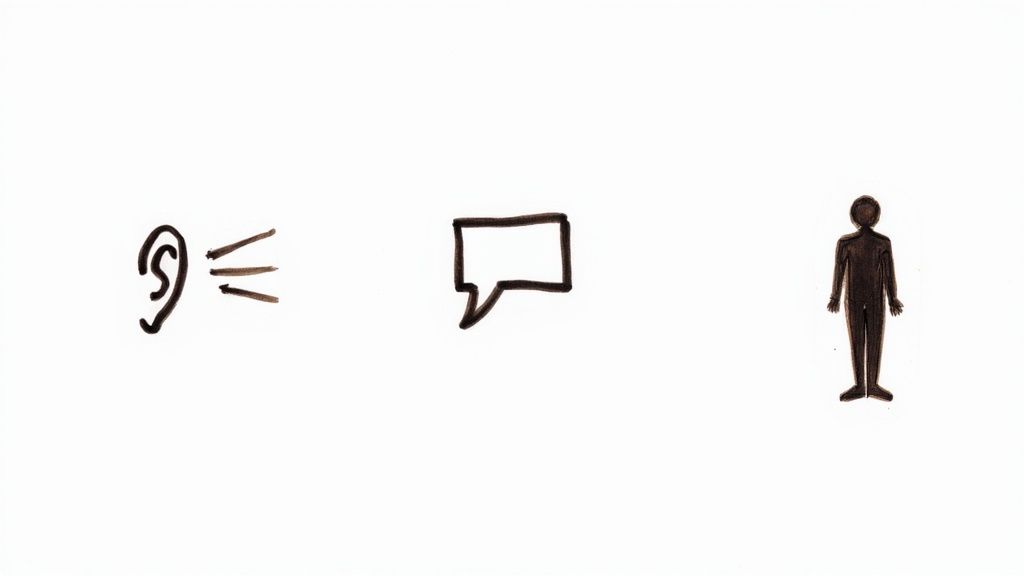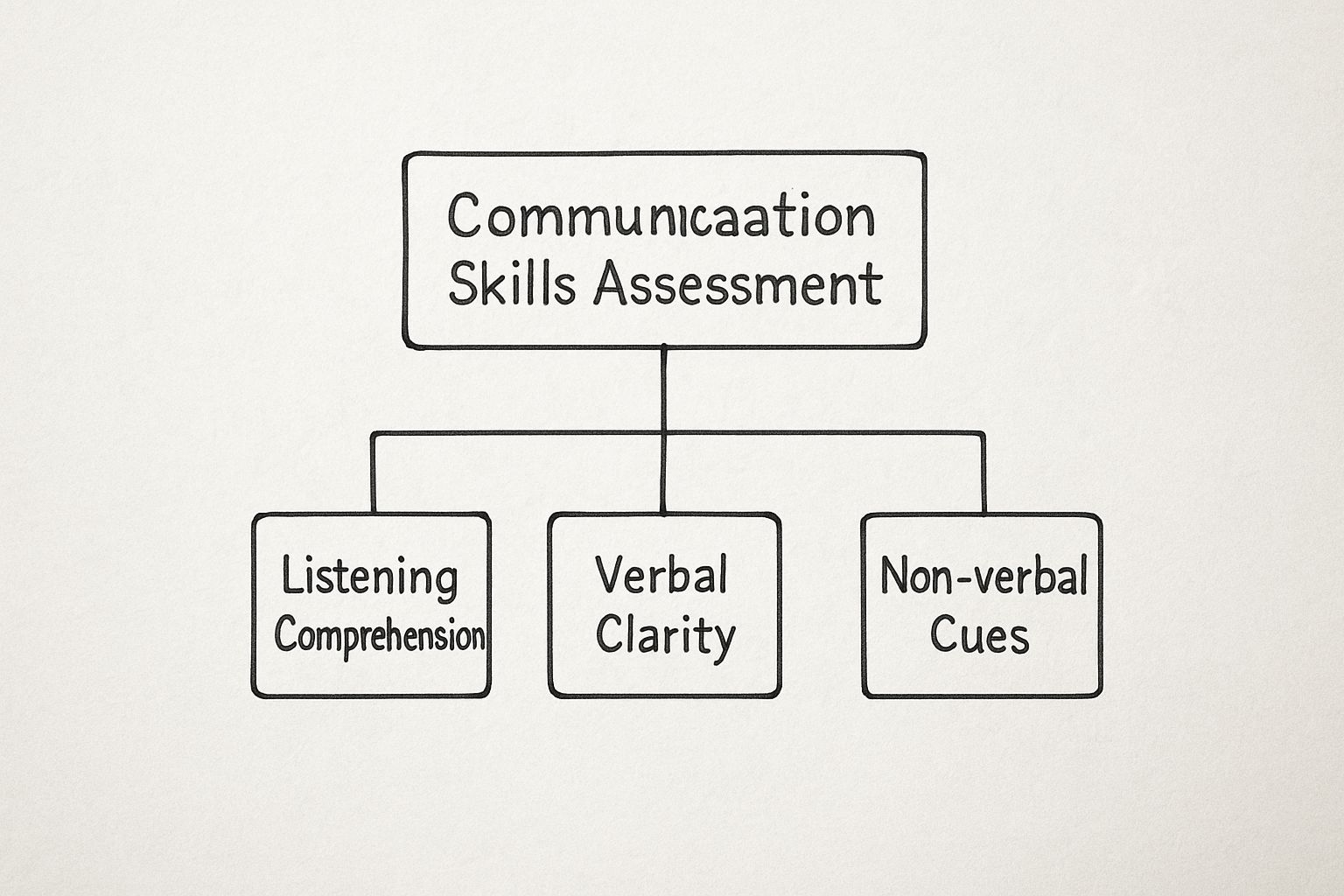A Guide to Communication Skill Assessment Tests

So, what exactly is a communication skills assessment? Think of it as a structured way to see how well a candidate can actually send and receive information. It cuts through the fluff of a resume and goes deeper than a standard interview, giving you hard data on things that truly matter in the workplace—like clarity, listening, and empathy.
Why Communication Skills Are a Hiring Superpower

In a market overflowing with technically skilled people, the real game-changer isn't what someone knows. It’s how well they can share their ideas, connect with colleagues, and collaborate to get things done. Smart companies have figured out that their most expensive hiring mistakes almost always come down to a weakness in these fundamental skills.
Here’s a good way to think about it: technical skills are like a car's engine. They provide the raw power needed to move forward. But communication skills? That’s the steering, the brakes, and the navigation system. Without them, all that horsepower is just chaos waiting to happen. A brilliant developer who can't explain a complex issue to a non-technical manager is an engine without a steering wheel—powerful, but ultimately useless.
This is exactly where a communication skill assessment test becomes one of the most valuable tools in your hiring toolkit. It takes the guesswork and "gut feelings" out of the equation and gives you a structured, data-driven way to predict how a candidate will perform once they're actually on the job.
Moving Beyond Interview Performance
We’ve all been there. You meet a candidate who is incredibly polished and articulate during a 45-minute interview, only to find out they struggle to collaborate with the team day-to-day. They nailed the conversation but stumbled on the actual communication.
The hard truth is that great interviewers are not always great communicators in a real work environment. Assessments help bridge this gap by simulating workplace scenarios that reveal a candidate's true capabilities.
This gap between interview performance and on-the-job reality creates friction, grinds projects to a halt, and can sour team morale. The real goal is to find people who can stay clear, empathetic, and professional under pressure—not just when they’re trying to land the job.
The data backs this up. A study by the National Association of Colleges and Employers (NACE) found that employers consistently rank communication skills among the most desired attributes in new hires, yet a significant portion of managers feel recent graduates are lacking in this area.
The True Cost of Poor Communication
Hiring someone with weak communication skills isn't just an annoyance—it's a direct hit to your bottom line. Every misunderstood instruction leads to wasted hours of rework. Every unresolved conflict breeds a toxic culture. And every poorly handled client interaction risks losing valuable business. According to a report from The Economist Intelligence Unit, communication barriers result in an average loss of $62.4 million per year for large companies.
Even a candidate's follow-up process reveals a lot. Learning about crafting effective follow-up emails after interviews is a perfect example of where a strong communicator shines, showing attention to detail and professionalism. By using a data-backed approach that includes tools like a personality assessment for hiring, you can build a much more reliable and complete picture of who you’re bringing onto the team.
What a Communication Assessment Actually Measures

It’s a common misconception that a communication assessment is just a glorified grammar and spelling test. While the mechanics of language do play a small part, they're just the tip of the iceberg. A truly effective assessment goes much deeper, measuring how someone applies their skills when the pressure is on.
Think of it this way: knowing the rules of the road is one thing, but safely navigating rush-hour traffic is another entirely. These tests put candidates in that simulated traffic. They reveal how a person communicates in complex, high-stakes scenarios where clarity, conciseness, and empathy aren't just nice-to-haves—they're essential.
These assessments are built around four foundational communication skills, each giving you a unique window into a candidate's real-world abilities.
Written Clarity
This is about so much more than a well-structured sentence. It’s about how a candidate organizes their thoughts, conveys the right tone, and shows empathy through the written word. You get answers to critical questions, like: Can this person calm down an angry client over email? Can they write a project update that a busy executive can scan and immediately understand?
For instance, a test might give a candidate a simulated email from a frustrated customer. The real test isn't whether they can write back without typos, but whether they can craft a message that actually solves the problem.
Does the response:
- Sincerely acknowledge the customer's frustration?
- Clearly explain the next steps without confusing jargon?
- Maintain a professional and genuinely helpful tone?
This is how you separate the people who can simply write from those who can write to get a specific result.
Verbal Articulation
Speaking clearly is important, but in an assessment, "articulation" is about the whole package. It measures a person's ability to build a logical argument, simplify a complex topic, and shift their speaking style to match their audience.
A well-designed communication skill assessment will often use video response tasks to gauge this. A candidate might be asked to record a short explanation of a new process or a pitch for a new idea. This reveals their ability to organize their thoughts on the fly and present information in a compelling, logical sequence.
This gives you a direct preview of how they’ll perform in a team meeting, a client presentation, or even a tough conversation with a coworker. It turns a subjective interview "feel" into objective, measurable data.
Active Listening
Communication is a two-way street, and you could argue that listening is the more important direction. Active listening isn't just hearing words; it's understanding the context, intent, and emotion behind them. A quality assessment will measure this with comprehension and situational judgment tasks.
A scenario might ask a candidate to watch a short video of a team meeting and then answer questions about the group’s dynamics. For example:
- Who seemed most hesitant to agree with the final plan?
- What was the unspoken concern behind the marketing lead's questions?
- Based on what you heard, what is the most critical follow-up action?
These kinds of questions dig into a candidate's ability to "read the room"—a vital skill for great collaborators and leaders.
Non-Verbal Awareness
Finally, a modern assessment, especially a video-based one, looks at non-verbal cues. This isn't about judging someone's appearance. It's about decoding the subtle signals that give our words meaning. While the popular statistic that "93% of communication is non-verbal" has been widely debated and is often taken out of context from its original 1960s study by Albert Mehrabian, the underlying principle holds true: non-verbal cues significantly impact how a message is received.
Platforms powered by AI, like MyCulture.ai, can analyze factors like tone of voice, pace of speech, and even facial expressions to gauge things like confidence, engagement, and emotional intelligence. This adds an objective layer to that gut feeling you get about a candidate, helping you pinpoint people who can build trust and rapport from day one.
The Four Core Competencies That Predict Success
While the basics—written clarity, verbal articulation, active listening, and non-verbal awareness—are the bedrock of good communication, four specific competencies truly separate the great communicators from the merely good ones. These are the applied skills that have a direct line to on-the-job success and real business results.
Think of it like building a house. The four pillars are the concrete foundation; they're essential, but you don't really see them. The core competencies, however, are the walls, the wiring, and the plumbing. They're the functional systems that make the house work and give it value. A solid assessment gives you the blueprint to a candidate's true performance potential.
Clarity and Conciseness
In the business world, everyone's attention is a limited resource. Being able to get your point across quickly and without causing confusion isn't just a nice-to-have skill; it's a sign of respect for other people's time. Clarity and conciseness mean stripping an idea down to its most essential parts and delivering it in a way anyone can immediately grasp.
This is critical in every single role, whether you're an engineer writing technical docs or a marketer drafting a project brief. It’s the difference between an email that creates five more questions and one that gets an immediate, decisive "yes."
Active Listening
Here's a secret: great communication is often more about shutting up than speaking. Active listening is the art of hearing what isn't being said. It's about catching those subtle cues, understanding the real concerns hiding beneath the surface, and making people feel genuinely heard.
A candidate who is a strong active listener is far more likely to resolve conflicts, build trust with clients, and work wonders in a team. They don't just solve the problem you hand them; they uncover the root cause by truly understanding what others need.
This skill is the foundation of strong relationships, both with colleagues inside the company and with customers out in the world. It’s how you turn a simple transaction into a lasting partnership.
Empathy and Emotional Intelligence
Empathy is about seeing the world from someone else's shoes, while emotional intelligence (EI) is the bigger picture—being able to perceive, understand, and manage emotions in yourself and others. Put them together, and you get someone who can "read the room" and adjust their communication style to fit the moment.
A customer support agent with high empathy doesn't just stick to a script; they recognize the frustration in a caller's voice and shift their tone to de-escalate the tension. Making the customer feel understood is often more powerful than the solution itself. If you want to dive deeper, you can explore the main theories of emotional intelligence to see how they play out at work.
Persuasion and Influence
Finally, you have the skills that move people to action: persuasion and influence. This isn't about manipulation. It's about building a compelling case, articulating a clear vision, and inspiring others to get on board. For leaders, salespeople, or anyone who needs buy-in from stakeholders, this competency is absolutely essential.
Think of a sales leader who can frame a product’s value so it perfectly matches a client's biggest headache. Or a project manager who gets the whole team excited about a new process by painting a clear picture of the benefits. Persuasion is the engine that drives progress.
This infographic gives a great high-level view of what a comprehensive communication assessment really looks at.

As the diagram shows, a strong assessment goes way beyond just checking for good grammar. It digs into fundamental abilities like comprehension, clarity, and the knack for interpreting those all-important unspoken signals.
Mapping Communication Competencies to Job Roles
So, how do you make this practical? You can start by mapping these competencies directly to your open roles, turning these abstract ideas into a real-world hiring tool. The following table shows how different jobs lean on different communication skills.
| Job Role | Primary Competency | Secondary Competency | Example Assessment Task |
|---|---|---|---|
| Sales Leader | Persuasion & Influence | Active Listening | Simulate a sales call where the candidate must overcome objections from a skeptical prospect. |
| Customer Support Agent | Empathy & Emotional Intelligence | Clarity & Conciseness | Respond to a simulated angry customer email, aiming to de-escalate and provide a clear solution. |
| Project Manager | Clarity & Conciseness | Persuasion & Influence | Draft a project update email for executives that clearly outlines progress, risks, and next steps. |
| Software Developer | Clarity & Conciseness | Active Listening | Explain a complex technical concept in simple terms for a non-technical audience in a short video. |
By tailoring your assessments this way, you stop guessing and start making data-backed decisions about who has the communication chops to truly excel in a specific role.
Comparing Communication Assessment Formats and Tools

Picking the right communication skill assessment test feels a lot like choosing the right tool for a job. You need to know what you're trying to build. The format you select has to match the specific skills you need to measure and, just as importantly, the role you’re trying to fill.
It’s easy to assume all assessments are the same, but they’re not. Each type strikes a different balance between scalability, cost, and the depth of insight it provides. Some are perfect for sifting through a huge applicant pool, while others give you a much richer, more nuanced picture of a candidate's actual abilities. Let's dig into the most common formats to see which one makes the most sense for you.
Multiple-Choice Questions (MCQs)
Multiple-choice questions are the classic, go-to format for testing at scale. They usually put a candidate in a common workplace scenario and ask them to pick the best response from a few options. It’s a straightforward way to check for situational judgment and a baseline understanding of professional etiquette.
- Pros: Fantastic for handling large numbers of applicants, very cost-effective, and scoring is completely automated.
- Cons: They can feel a bit robotic and don't always predict how someone will actually act. It's more of a knowledge check than a true skill demonstration.
Think of MCQs as an initial filter. They’re best used early in the process to weed out candidates who don’t have a foundational grasp of professional communication.
Written Response Tasks
Taking a step up, written response tasks ask candidates to actually create something. This could be anything from drafting an email to a frustrated customer to writing a quick project update for the team.
This is where you get a real look at their writing style, tone, and how they organize their thoughts. It’s a far more authentic test of empathy, clarity, and professionalism than a multiple-choice question could ever be. You’re getting a genuine work sample.
The magic of a written task is seeing how a candidate communicates under a little pressure. It’s a direct window into their ability to be clear, concise, and persuasive when it counts—moving from what they know in theory to what they can do in practice.
Video Interviews and Responses
Video assessments are incredibly popular for a reason—they offer a powerful, multi-dimensional view of a candidate. In this format, applicants record video answers to your questions, giving you a chance to evaluate their verbal communication skills head-on. You get to see their articulation, hear their tone, and even pick up on non-verbal cues like confidence and body language.
This is your chance to see how they explain a tricky concept on the fly or how they carry themselves. It adds a layer of depth that written words just can't capture, giving you a feel for their interpersonal skills. If you're weighing your options, exploring guides on various communication assessment tools can help you find the right fit for your needs.
Immersive Role-Playing Simulations
At the very top of the scale, you’ll find immersive simulations. These high-fidelity assessments drop candidates right into realistic, interactive workplace scenarios. They might be asked to navigate a tough conversation with an employee, jump into a simulated team meeting, or handle a live chat with an unhappy customer.
- Pros: Delivers the most realistic and predictive data on how someone will perform on the job.
- Cons: Naturally, they are more expensive and time-consuming, making them best for late-stage candidates in business-critical roles.
Simulations are the gold standard when communication is the absolute core of the job—think leadership, sales, or high-stakes customer-facing roles.
This entire field has also been pushed forward by AI-powered platforms that can analyze verbal and non-verbal skills in great detail. Modern tools can even detect emotional intelligence by analyzing tone and word choice for empathy, often using accent-neutral tech to keep things fair. The best approach today is to combine automated AI scoring with live interaction to get a complete picture.
Using Assessment Results to Make Smarter Hires
Getting the data back from a communication skills test is the easy part. The real work begins when you have to translate those scores and reports into a smart, confident hiring decision.
Without a solid plan, a pile of assessment results can feel overwhelming. Worse, they can be misused. The goal isn't just to collect numbers; it’s to weave that information into the very fabric of your hiring process. Let's walk through how to make the data work for you.
Set Clear Benchmarks Before Testing
Before you even think about sending an assessment to a candidate, you need to define what "good" actually looks like for the role. Think about it: the communication skills that make a top-tier salesperson successful are entirely different from what makes a software engineer shine in their technical documentation.
Sit down with your hiring team and pinpoint the one or two communication skills that are absolutely essential for success in the job. Is it persuasion? Clarity? Empathy? Once you know what matters most, establish a baseline score or percentile that you consider a minimum requirement. This keeps you from moving the goalposts and ensures every single candidate is measured by the same objective yardstick.
Integrate Data into a Holistic Review
A communication assessment is a powerful piece of the puzzle, but it’s still just one piece. The results should never be the sole reason you hire or reject someone. The magic happens when you use the data to add color and context to everything else you know about the candidate—their resume, their portfolio, and how they show up in an interview.
Here's how that might look in practice:
- A low score in written clarity? Don't just dismiss them. Instead, bring a sample of their writing into the interview and ask them to walk you through their thought process.
- An exceptional persuasion score? Great! Use the interview to dig into their sales experience and ask for specific examples of how they've put that skill to work.
This approach turns the assessment from a simple pass/fail gate into a guide for asking smarter, more insightful questions. There are many pre-employment assessment tools out there, so find one that helps you build this complete picture.
The best hiring managers don't see assessment results as a final verdict. They see them as a conversation starter. The data points you toward areas worth exploring, helping you validate a candidate’s strengths and gently probe potential weaknesses during the interview.
Understand the Nuances in the Report
Reading an assessment report is more art than science. A single number rarely tells the whole story. For example, a percentile score of 65% doesn't mean the candidate got 65% of the answers correct. It means they performed better than 65% of the people in the comparison group—a huge difference.
Instead of getting hung up on one number, look for patterns. Is the candidate consistently strong in people-focused skills like empathy but a bit weaker when it comes to clarity and conciseness? That insight is far more useful than a single, combined score.
Distinguish Red Flags from Coachable Weaknesses
Not every low score is a deal-breaker. The final, critical step is learning to tell the difference between a red flag and a coachable weakness.
A red flag is a major gap in a skill that’s non-negotiable for the role. For instance, a customer support manager with a rock-bottom empathy score is a clear red flag. You can't really teach that on the job.
On the other hand, a talented junior designer who scores moderately on verbal articulation might just need some coaching and practice to become a great presenter. That's a coachable weakness. Using the data this way helps you spot high-potential candidates who just need a little polish, and it makes it much easier to pass on those who truly aren't the right fit.
The Future of Communication Skill Assessment
Let's be clear: using a communication skill assessment is no longer a "nice-to-have" recruiting tool. It's a strategic move that directly invests in the future of your company. We're seeing a massive shift in how organizations evaluate talent, moving away from gut feelings and toward data-backed decisions to build stronger, more effective teams. This isn't just a temporary trend; it’s a fundamental change in how we find and grow the right people.
The numbers tell the same story. According to a 2023 market analysis report by Polaris Market Research, the global pre-employment testing market was valued at USD 6.51 billion in 2022. The report projects it will grow to USD 22.9 billion by 2032.
That’s a compound annual growth rate (CAGR) of 12.1%, which signals a huge industry-wide commitment to smarter, more objective hiring. The scale of this shift is hard to ignore.
What Comes Next for Assessments
Looking down the road, the technology driving these assessments is getting seriously impressive. We're starting to move past simply evaluating one person at a time and into a world of dynamic, team-based insights. Think about AI that can analyze how an entire team communicates, flagging potential friction points or even predicting a project's success before it gets off the ground.
The next frontier is about holistic understanding. It’s not just about how one person communicates, but how their style integrates with the team, creating a more cohesive and productive whole.
We can also expect to see incredibly realistic testing scenarios thanks to virtual and augmented reality (VR and AR). These simulations will drop candidates right into the middle of tough workplace situations, like navigating a tense client negotiation or managing a sudden team crisis. The data we'll get from these tests will be more predictive and accurate than anything we've seen before.
For more on where this is all heading, including the role of AI in communication, it’s worth checking out Parakeet AI's blog for industry insights. By adopting a modern communication assessment now, you’re setting your organization up to lead the way into this exciting future, not just react to it.
Frequently Asked Questions
It's natural to have questions when you're thinking about adding a new tool to your hiring process. When it comes to something as important as a communication skill assessment test, you want to be sure it's fair, effective, and won't put off the very people you're trying to attract. Let's tackle some of the most common concerns head-on.
Are These Assessments Fair to All Candidates?
Absolutely, as long as they are designed correctly. In fact, the whole point of a standardized assessment is to make hiring more fair by swapping subjective "gut feelings" for objective, measurable data. A good test creates a level playing field for everyone.
Reputable platforms ensure their questions are validated across diverse demographic groups, which helps root out cultural or linguistic bias. For instance, many of today's video-based assessments use accent-neutral AI to focus on clarity, tone, and word choice, so non-native English speakers aren't at a disadvantage.
Will Assessments Scare Away Good Candidates?
This is a valid worry, but experience shows the opposite is usually true. When you clearly explain the purpose of the assessment, it sends a powerful signal to top candidates: you're serious about building a high-performing team and you value a professional, thorough process.
A study by SHRM (the Society for Human Resource Management) found that 82% of companies using pre-hire assessments believe the quality of their hires has improved. This tells us that not only are the right candidates willing to take these tests, but the process actually works to identify them.
The key is transparency. Let candidates know why you use the assessment and what it measures. This simple step shows you respect their time and can make your company stand out as an employer of choice.
How Long Should a Communication Assessment Take?
The sweet spot is typically between 15 and 30 minutes. This gives you enough time to gather genuinely useful insights without causing candidate fatigue.
Go too short, and you might only get a surface-level impression. Go too long, and you risk talented, busy professionals dropping out of the process. A well-designed test focuses on quality over quantity, using just a few smart scenarios to reveal a candidate's core communication skills.
Ready to build a stronger, more collaborative team with data-driven insights? MyCulture.ai provides science-backed assessments to help you evaluate candidate communication skills and culture fit with confidence. Start making smarter hires today.